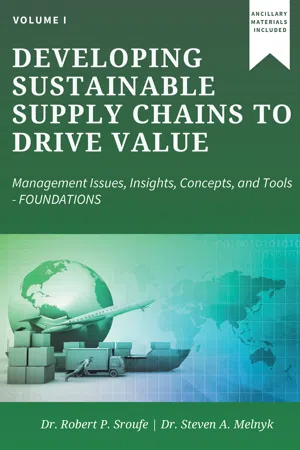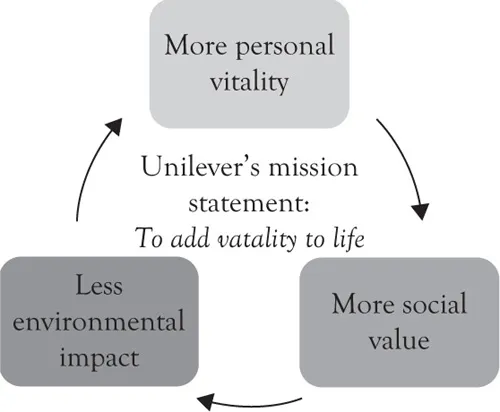
eBook - ePub
Available until 23 Dec |Learn more
Developing Sustainable Supply Chains to Drive Value
Management Issues, Insights, Concepts, and Tools—Foundations
- 204 pages
- English
- ePUB (mobile friendly)
- Available on iOS & Android
eBook - ePub
Available until 23 Dec |Learn more
Developing Sustainable Supply Chains to Drive Value
Management Issues, Insights, Concepts, and Tools—Foundations
About this book
This book provides a multi-perspective approach to sustainability and value chains to allow understanding from a variety of disciplines and professional backgrounds. Some of the key features of this book include:
- Short vignettes of important trends along with relevant management issues;
- Evidence-based management examples from leading multinational companies, as well as small and medium enterprises spanning supply chains;
- References to appropriate tools, emerging technology, and practices;
- Chapter action items for the reader to take a deeper look at integration opportunities involving sustainability and supply chain management;
- An action-learning approach to applying concepts and tools so readers from any functional perspective can implement and manage sustainability projects;
- and guidelines on how to move forward with your supply chain sustainability initiative.
Frequently asked questions
Yes, you can cancel anytime from the Subscription tab in your account settings on the Perlego website. Your subscription will stay active until the end of your current billing period. Learn how to cancel your subscription.
At the moment all of our mobile-responsive ePub books are available to download via the app. Most of our PDFs are also available to download and we're working on making the final remaining ones downloadable now. Learn more here.
Perlego offers two plans: Essential and Complete
- Essential is ideal for learners and professionals who enjoy exploring a wide range of subjects. Access the Essential Library with 800,000+ trusted titles and best-sellers across business, personal growth, and the humanities. Includes unlimited reading time and Standard Read Aloud voice.
- Complete: Perfect for advanced learners and researchers needing full, unrestricted access. Unlock 1.4M+ books across hundreds of subjects, including academic and specialized titles. The Complete Plan also includes advanced features like Premium Read Aloud and Research Assistant.
We are an online textbook subscription service, where you can get access to an entire online library for less than the price of a single book per month. With over 1 million books across 1000+ topics, we’ve got you covered! Learn more here.
Look out for the read-aloud symbol on your next book to see if you can listen to it. The read-aloud tool reads text aloud for you, highlighting the text as it is being read. You can pause it, speed it up and slow it down. Learn more here.
Yes! You can use the Perlego app on both iOS or Android devices to read anytime, anywhere — even offline. Perfect for commutes or when you’re on the go.
Please note we cannot support devices running on iOS 13 and Android 7 or earlier. Learn more about using the app.
Please note we cannot support devices running on iOS 13 and Android 7 or earlier. Learn more about using the app.
Yes, you can access Developing Sustainable Supply Chains to Drive Value by Robert P. Sroufe,Steven A. Melnyk in PDF and/or ePUB format, as well as other popular books in Economics & Operations. We have over one million books available in our catalogue for you to explore.
Information
SECTION II
The Foundations of Sustainable Supply Chain Management
CHAPTER 3
Sustainability—Generating a Strategic Competitive Advantage
Is There Demand for Sustainability?
Underlying the information within this chapter is a critical assumption—there is a demand for products and services that are sustainable. There is strong evidence indicating that customers (especially in economically developed markets and emerging markets) are, in fact, demanding products that are more sustainable. Consider the following statistics:
- 54 percent of shoppers indicate that they consider elements of sustainability (sourcing, manufacturing, packaging, product use, and disposal) when they select products and stores.1
- 80 percent of consumers are likely to switch brands, given that they are equal in quality and price, to ones that support a social or environmental cause.2
- 47 percent of consumers said that they bought products from a socially or environmentally responsible company, with this percentage expected to go up to 76 percent within one year.3
In other words, consumers and business-to-business customers are interested in sustainable products and services, and in the companies that produce them. Sustainability and sustainable supply chain management are about meeting and exceeding customer needs in new, more efficient and effective ways.
Objectives
- Understand how leading companies are taking advantage of the sustainability opportunity.
- Recognize the role of business models in making sustainability a strategic imperative.
- Appreciate the importance of developing environmental and social sustainability capacity with increased transparency.
Paul Polman Transforms Unilever
Most people know Unilever, an Anglo-Dutch multinational consumer goods company. Its products include food, beverages, cleaning agents, and personal care products. It is the world’s third largest consumer goods company in terms of sales revenue (just after Procter & Gamble and Nestlé). One indication of Unilever’s success and global reach is that over 200 million times a day someone in the world is using a Unilever product. Most CEOs would be happy to live with this status quo. Not Paul Polman.
His view is to transform Unilever from a company that does well financially to a company that positively contributes to society and the environment. To undertake this transformation, Polman is shifting Unilever’s focus. At the heart of this new focus is the Unilever Sustainable Living Plan.4 The Living Plan identifies seven new key strategic supply chain imperatives, with the goal to meet them by 2020:5

Unilever’s approach to sustainability.
The key seven strategic supply chain imperatives
- Health and Hygiene: Unilever will help more than a billion people to improve their hygiene habits and bring safe drinking water to over half a billion people.
- Nutrition: Unilever will double the proportion of the product portfolio that meets the highest nutritional standards, thus helping people achieve a healthier diet.
- Greenhouse Gases: It is Unilever’s goal to halve the GHG impact of products across their lifecycle (from sourcing to product use and disposal).
- Water: Unilever aims to halve the water usage associated with the consumer use of its products by 2020. The emphasis on this objective will be greatest in those countries that are populous and water scarce, countries where Unilever expects much of its future sales growth to take place.
- Waste: Unilever’s goal is also to halve the waste associated with the disposal of its products by 2020.
- Sustainable Sourcing: Unilever’s goal is to increase the amount of agricultural raw materials sourced sustainability from 10 percent to 30 percent by 2012, to 50 percent by 2015, and ultimately to 100 percent by 2020.
- Better Livelihoods: Unilever’s goal is to link into the supply chain more than 500,000 smallholder farmers and small-scale distributors so that they can benefit by working with Unilever.
When we look at Paul Polman’s vision of Unilever’s future, we see a vision that is potentially risky. One that raises the question of whether a vision that so closely embraces sustainability (from an environmental and social perspective) can really be sustainable (as measured from a business perspective). Yet, it is a vision that Polman is now projecting onto Unilever as he looks to the developing countries to be the source not only of future demand and population growth, but also of future supply. This new vision is necessary to achieve this shift in strategic focus from the developed to developing countries.
That issue will be explored in this chapter, as we develop a deeper level of what sustainability is and is not and how sustainability can be a strategic weapon, rather than a legal constraint. This chapter is important because it is here that we establish many of the critical concepts on which an efficient and effective sustainable supply chain is built.
Understanding Sustainability
The triple bottom line (TBL) tries to address the sustainability opportunity by measuring it in accounting terms (i.e., dollars) so that management can identify those areas where it is doing a good job and areas where more work is required. First coined by Elkington (1994), this concept demands that the company be responsible not simply to stockholders, but rather to the stakeholders. Stakeholders, in this case, refer to anyone who is affected either directly or indirectly by the actions of the firm, including customers, workers, suppliers, investors, and even the environment. The goal of the TBL is to report and influence the activities of the firm as it affects financial, environmental, and social performance.
The TBL and the approach introduced in this book are not substitutes; rather, they are complements. The TBL identifies the goals to be achieved (the measurement of the financial, environmental, and social performance) but not how to achieve the balance or the best level of performance. The approach laid out in this chapter helps you better understand the options available to you. It provides you with the foundations on which the TBL can be successfully implemented and maintained over time. In some ways, the TBL may understate the focus of sustainability. The TBL views the three dimensions as areas to be measured. Although important, this view may not focus attention on what these three areas truly are—investments into three forms of capital—economic, natural, and social. As assets, these areas should generate returns that can be measured and managed appropriately to ensure positive rates of return and an integrated bottom line.
Sustainability is, in general, a poorly understood concept because it has been interpreted in many different ways. According to dictionary.com,6 sustainability has two definitions:
- The ability to be sustained, supported, upheld, or confirmed.
- The quality of not being harmful to the environment or depleting natural resources, and thereby supporting long-term ecological balance.
These two definitions highlight some of the reasons that confusion surrounds this concept. In the first definition, we can see the notion of business sustainability—developing an approach built around the business model that ensures ...
Table of contents
- Cover Page
- Title Page
- Copyright Page
- Contents
- Acknowledgments
- Section I: Introduction to the Sustainable Supply Chain
- Section II: The Foundations of Sustainable Supply Chain Management
- Section III: The Key Activities of a Sustainable Supply Chain
- References
- Index